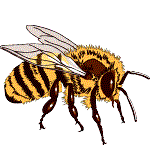Africanized Honeybee Pest Profile


Description
It is extremely difficult to distinguish the Africanized Honeybee (AHB) from European Honeybees (EHB). Only after complex laboratory analysis of morphological characters is it possible to state the probability that a group of bees is Africanized. That is, scientists have developed a probability table using 0.00 to indicate absolute assurance that bees are European and 1.00 to indicate absolute assurance that bees are Africanized.
History & Economic Importance
Major behavioral differences which distinguish AHB from EHB are general excitability, defensiveness, frequent swarming, and an ability to nest in a wide range of sites. Swarming is the primary mode of spread. When a swarm finds a suitable nesting site, it may nest there and construct combs. If a shortage of food, water, or space develops, a swarm will move (abscond) to a more suitable location. As the number of bees in the nest increase, they produce reproductive swarms which seek new nesting sites. Reproductive swarming can occur every six weeks, especially during heavy nectar flow periods.
Life Cycle
The following is a brief description of the complete metamorphosis:
Egg: The eggs are white and sausage shaped. The caudal (oval) end of the egg is attached to the base of the cell. A fertilized egg develops into a female bee (worker); a non-fertilized egg develops into a male bee (drone). Hatching occurs when the egg is approximately 60 hours old.Larva: Larvae are fed glandular secretions originating in the head of young nurse bees. Larva destined to become queens are mass fed on royal jelly in a peanut-shaped cell. Eight days after the egg is laid, the cell containing the worker is capped, and on the ninth day the larva spins a cocoon. The prepupal stage is reached on the tenth day.Pupa: On the eleventh day, the white and motionless pupal form is evident. From the thirteenth day to the twentieth day, the eye color develops. The twentieth day, the adult emerges from the cell.Adult Bees: The worker has a normal life of about 30 days. The normal life span of drones is five to 10 weeks. The queen usually lives from one to three years.
